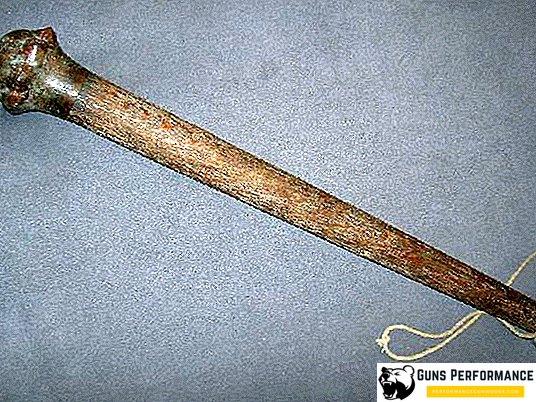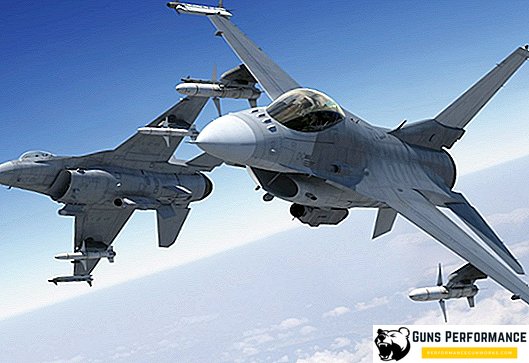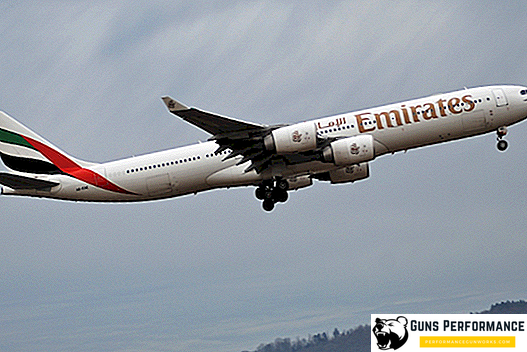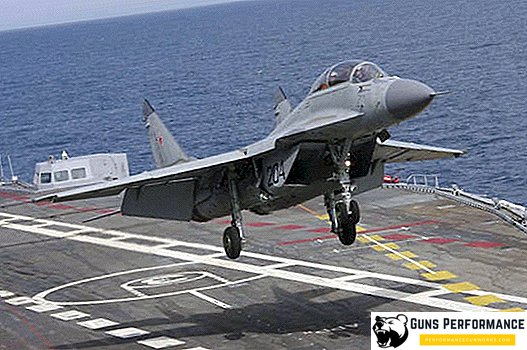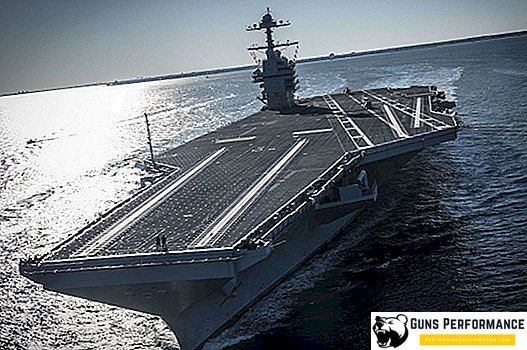
May 31, 2018 in the US Navy was introduced a new ship - the nuclear aircraft carrier "Gerald R. Ford" (USS Gerald R. Ford). This is the first transfer in eight years to the US Navy of a new nuclear aircraft carrier: in 2009, US sailors received the "George Bush" - the last aircraft carrier of the Nimitz type. The construction of the USS Gerald R. Ford began in 2005 and was launched on November 9, 2013.
"Gerald Ford" - not just a new aircraft carrier, it is the lead ship of the new series, which in the future should replace the deserved, but already somewhat outdated aircraft carriers such as the Nimitz and the Enterprise. After all, the first "Nimitz" was launched in the distant 1975.
In 2012, the CVN-65 Enterprise, the first US aircraft carrier with nuclear installation, was withdrawn from the US fleet. It was commissioned in 1961. "Gerald Ford" should take his place.
The design and construction of the new ship involved Newport News Shipbuilding. However, this is not surprising, because it owns the only shipyard in the USA where aircraft carriers can be built. It was on it were made all the ships of the type "Nimitz".

The aircraft carrier Gerald R. Ford is the most complex and expensive warship in the history of mankind. It cost the US taxpayers nearly $ 13 billion, and another $ 5 billion was spent on design and research. The second aircraft carrier of this series will cost $ 9.2 billion, and the third - $ 10.7 billion. The service life of ships of this type is 50 years.
"Gerald Ford" will begin to perform combat missions only in 2020, before this point will be tested and debugged ship systems.
In 2018, the second aircraft carrier of this project, the CVN-79 "John F. Kennedy," was laid, its launch is expected next year, and it will tentatively be accepted as part of the fleet in 2022. In 2018, the third ship of this series will be laid - CVN-80 Enterprise. It is planned that after the transfer of the project’s lead ship to the military every five years, a new aircraft carrier will be put into operation, gradually replacing the old ships of the Nimitz type. The last aircraft carrier of this series will be launched in 2058.

Experts (especially American ones) do not skimp on laudatory epithets when describing a new ship. "Gerald Ford" is called the "supercarrier", "the symbol of American power," "aircraft carrier of the 21st century" and "ship, which will ensure the superiority of the US Navy in the coming decades." Is it so?
The history of the creation of the aircraft carrier Gerald R. Ford
The program to create an aircraft carrier of a new type was launched in 1996. Promising ship received the designation CVN (X) or CVN-21. A special commission was formed, which, together with representatives of the Navy and the military-industrial complex, developed the requirements for the main characteristics of the future ship. Special attention was paid to the operational flexibility of its use, as well as to new technologies that can improve the combat qualities of an aircraft carrier and reduce the costs of its construction and operation.
It was originally planned to build a ship with a displacement of about 100 thousand tons, with a nuclear power plant (NPI) and a flight deck, which could be used for take-off and landing all types of existing and future aircraft of carrier-based aircraft. The developers were required to create such a ship power system that would not only provide high speed and unlimited navigation range, but also give enough energy for weapons systems based on new physical principles.

The commission also made a number of proposals relating to the survivability of the future aircraft carrier and reducing the cost of its construction and operation. In one of the initial projects, the ship was planned to be built with a significant use of stealth technology, giving its hull a completely fantastic view with characteristic angular contours. However, after calculating the cost of such ideas quickly abandoned. In addition to increasing the combat capabilities of the future aircraft carrier, the designers were looking for ways to reduce the cost of its life cycle. The cost of a 50-year aircraft carrier operation is approximately $ 21-22 billion, much of which goes to the maintenance of the crew and maintenance of the reactor.
During the design of a new aircraft carrier, much attention was paid to reducing its radar visibility. The developers did not plan to make the aircraft carrier completely invisible to radar, their task was to lower the ship's ESR so that it did not differ from other aircraft carrier ships.
Construction of the first ship of this project - aircraft carrier "Gerald Ford" - began in 2005. The timing of its adoption into operation several times postponed. Initially, the aircraft carrier was planned to be adopted in 2014, then the deadline was postponed to the end of 2018. The reason for the delays was a large number of innovative technological solutions used during construction, as well as new components and assemblies that were installed on the aircraft carrier.

Despite a positive assessment of the combat capabilities and effectiveness of a new type of aircraft carrier, a number of American experts have seriously criticized it. First of all, it concerns the high cost of new ships, as well as their dubious effectiveness in future wars. Many questions are caused by an electromagnetic catapult for takeoff of aircraft - one of the main "highlights" of this project. Recently, even the newly elected US President Donald Trump spoke on this subject. He said that this technology has not yet been fully developed, and it is better to replace the electromagnetic catapults with the usual steam ones. However, the ship has already been put into service, and now hardly anyone will expose it to such a significant alteration.
Design features of the aircraft carrier Gerald R. Ford
The aircraft carrier "Gerald Ford" has a displacement of 100 thousand tons and the layout of the hull is in many ways similar to the American aircraft carriers of the previous series. On the other hand, the Nimitz can be called one of the most successful series of American warships, so it was unlikely that significant changes were necessary. There is information that subsequent aircraft carriers of this project will be very different from the lead ship. The media wrote about the possible use of the "catamaran" scheme, which will significantly increase the area of the takeoff deck.

With almost the same size as the Nimitz, the number of crew on new aircraft carriers will be reduced by 500-1000 people, which will significantly reduce operating costs. A similar result will be achieved due to greater automation of the processes, as well as a reduction in the laboriousness of servicing ship systems and units. The number of crew "Gerald Ford" - 4660 people.
Superstructure (island) "Gerald Ford" is located on the starboard side and has a slightly smaller size than the "Nimitz". She shifted to the stern and taken out of the line of the board. Antennas are installed on the superstructure, as well as systems that ensure the take-off and landing of aircraft. The aircraft carrier has four catapults, an angular flight deck, 18 points for refueling and arming aircraft. The ship is equipped with a system for monitoring stability and displacement.
The aircraft carrier "Gerald Ford" has four aircraft lifts. When installing new equipment or weapon systems, you can quickly change the configuration of the interior of the vessel.

The power plant of the aircraft carrier consists of two reactors A1B, specially designed for this ship. They produce significantly more electricity than the Nimitz aircraft carrier reactors (some sources speak of a threefold superiority), and the complexity of their maintenance is also significantly reduced. But that's not all. One of the main sources of operating costs for aircraft carriers is the reactor; replacing nuclear fuel is especially expensive. Reactors "Gerald Ford" designed for 50 years of service and during this period do not need recharging. Electric power is needed to the ship not only to provide the course, but also to power various ship systems, including electromagnetic catapults. The maximum speed of the carrier will be 35 knots, cruising range is unlimited.
The main part of the ship’s radar equipment is dual-band DBR radar, which consists of two components. This is an AN / SPY-3 X-band radar and S-band VSR radar. Initially, this system was developed for the "Zamvoltov" - destroyers of the new generation.
As a means of self-defense, Gerald Ford will be armed with anti-aircraft missiles RIM-162 ESSM. They are primarily intended to destroy high-speed anti-ship missiles. At short distances against enemy aircraft and missiles will be involved anti-aircraft missiles RAM. It is likely that laser armament will be placed on the aircraft carrier, the considerable power of the power plant makes it possible to do so.
Also on the "Gerald Ford" will use the new system of storage and supply of ammunition.

However, the main weapon of any aircraft carrier is combat aircraft, which is on board. Aircraft wing "Gerald Ford" will exceed 75 aircraft of various kinds. Often called the number 90 aircraft and helicopters.
The strike aircraft aboard the "Gerald Ford" will be represented by F-35C and F / A-18E / F Super Hornet fighter jets (10-12 vehicles of each type), as well as electronic countermeasures EA-18G Growler (5 units ), DRLO E-2D Hawkeye planes (4 units) and two C-2 Greyhound transport vehicles. In addition, on board the aircraft carrier will deploy multi-purpose helicopters MH-60R / S, as well as UAVs. On the latter should say a few words separately. At first, the unmanned aerial vehicles belonging to the air group will feature the MQ-25 Stingray, which can be used to conduct reconnaissance and as air tankers. However, today in the United States voices are being heard about the need to place on board a new type of aircraft carriers of drone long-range UAVs.

Speaking of deck aircraft, which will be placed on the "Gerald Ford", one can not say about one of the main technological innovations of the ship - electromagnetic catapults and turboelectric aerofinishers. New catapults, created on the basis of a linear electric motor, make it possible to accelerate aircraft more smoothly, without damaging their structural elements. They provide greater controllability of the launch process, give aircraft the ability to take off at a wider range of directions and wind speeds. New aerofinishers are recognized as more reliable than their predecessors, they provide a smoother deceleration of the aircraft and reduce the load on its airframe.
It should be noted that in the development of catapults and finisher there were quite serious difficulties. The fleet management even planned to install a more traditional system for the next ship of the series, but now problems have been solved. The new aircraft carrier "Gerald Ford" will be able to provide 160 takeoffs during the day in normal conditions and up to 220 take-offs during combat operations.




